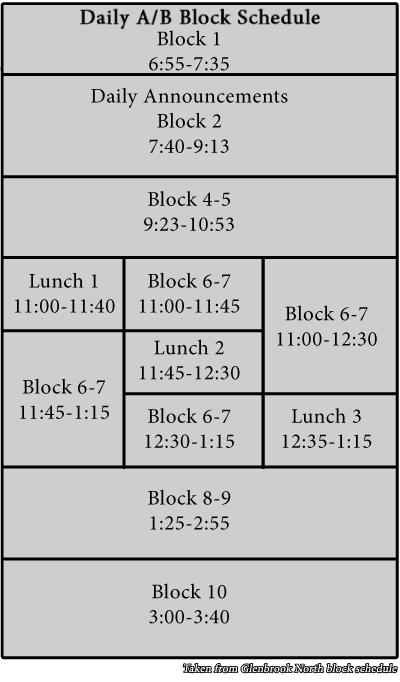Ninety minutes is a long time. In an hour and a half, I could finish a movie, watch half of a football game or listen to Pink Floyd’s Dark Side of the Moon—twice. And when I first learned that South would be ditching the eight-period system for the dreaded “block schedule” next year, I also learned I would be forced to sit through an entire class for that same amount of time.
There seemed to be some incredible hatred towards this significant change when it first surfaced. Petitions blanketed Facebook to prevent its implementation, yet no one seemed to explain their reason for such malcontent. On a student council field trip to North, however, I got the chance to observe a class on the block schedule, and after this experience, it is clear that the reason many people don’t appreciate the block schedule is because they simply do not know enough about it.
The atmosphere at North was nothing short of “chill.” The entire aura of not only the classes but the hallways during passing periods was a far cry from South’s erratic hallway dash, which is almost as congested as L.A. traffic on good days. No one was rushed, given the leisurely ten minute passing periods, and although the class time was notably longer, the day was already a quarter over by the time we were released.
It is ultimately up to the teacher and the student as to whether or not 90 minutes is a long time. With longer class times, teachers have an opportunity to creatively integrate student activities, and they should take full advantage of that. I was lucky enough to go to a class centered around student participation, but for my fellow StuCo-ers who chose lecture-based classes, the time was tedious and difficult to sit through.
There are certain aspects of the new scheduling that students can forthrightly appreciate: everyone will gain an extra period due to the built in lunches. Unfortunately, as a student in the Academy of International Studies, I will sacrifice this extra block, but for most students this is an opportunity to enjoy a 90-minute Student Resource Time (SRT), also known as a study hall, in addition to a chosen elective. But for those who are avid overachievers like me, an application process is required to fill all eight blocks with classes.
Although the alternating schedule means that each class is held every other day, according to a District-conducted survey, this sadly does not equate to fewer hours spent on homework. For expert procrastinators and students who do a good deal of their work during the day, when you take into account the extended passing periods and opportunities for a free period, it’s possible that we could be getting a few more hours of sleep at home.
Ultimately, there are many other nuances to the block schedule that make certain situations unique, but we can expect that information will be thoroughly distributed to students and families in the future. By the time the 2014-2015 school year comes around, students and parents will feel familiar with the changes and conceivably learn to enjoy them.
As you start to prepare your schedules for next year, I highly recommend that you take the opportunities presented by the block schedule and fill your extra blocks with classes you love or can benefit from. Make sure that your four or five core classes aren’t all on one day and budget your time. I’m confident that by the time students become acquainted with the block schedule, they will be wondering why we didn’t implement it sooner.








